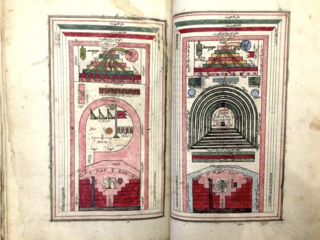Maʿrifetnāme (“The Book of Gnosis”)

Penned by İbrāhīm Ḥaḳḳī Efendi of Erzurum (d. AH 1194/1780 CE), copy from Seyyid ʿAbdī [bin Feyżu’llāh], 18th Century
Call number Turkish MSS Suppl 184
This manuscript, a work by Seyyid ʿAbdī [bin Feyżu’llāh] from HA 12041(1789–1790 CE), comprises 382 leaves with an additional 3 fly-leaves. The pages are numbered at the top left, with each pair of facing pages being considered as one. The text is written in black Naskh script and is framed within delicate gold-ruled borders2. The dimensions of this manuscript are 32 cm by 19.5 cm, and it features thirty-five lines per page. The Maʿrifetnāme, authored by İbrāhīm Ḥaḳḳī Efendi of Erzurum, is a renowned scholarly encyclopedia from the eighteenth century, deeply revered in Ottoman Anatolia. İbrāhīm Ḥaḳḳī Efendi completed this magnum opus in HA 1170/1757 CE, dedicating it to his son, Seyyid Aḥmed Naʿīmī.
İbrāhīm Ḥaḳḳī was not only a Sufi saint but also a polymath whose interests spanned various disciplines, including astronomy, mathematics, anatomy, psychology, philosophy, and Islamic mysticism. These diverse fields of study deeply informed his engagement with Sufism, particularly the concepts of ‘nafs‘ (the self) and self-knowledge, which are central to understanding his literary output. The ‘Maʿrifetnāme’ (Book of Gnosis) is a testament to his endeavor to bridge the gap between esoteric Sufi knowledge and the empirical sciences. He aims to make these concepts accessible to the layman, positioning the layman at the center of this reconciliation. Therefore, the manuscript represents a confluence of Sufi spirituality and scientific inquiry, reflective of İbrāhīm Ḥaḳḳī’s life and the intellectual milieu of Ottoman Anatolia. It emerges as both a scholarly text and a reflection of Ottoman intellect while being inclusive and embedded in Sufi mysticism and practices. It defines the epistemology in Ottoman Anatolia, and how it is connected to religion—a religion that seems to place the human at the center of the universe, living up to its name as the ‘Book of Gnosis,’ where the interplay of knowledge and spirituality reveals the universe through a uniquely human-centric lens.
Sources:
Gruber, Christiane. “Signs of the Hour: Eschatological Imagery in Islamic Book Arts,” in Ars Orientalis 44 (2014): 40–6.
Karamustafa, Ahmet. “Cosmographical Diagrams,” in Cartography in the Traditional Islamic and South Asian Societies, ed. John Harley and David Woodward, History of Cartography, vol. 2 (Chicago: University of Chicago Press, 1992), 71-89.
Soyyiğit, İsmail. “İbrahim Hakkı Erzurumî’de Nefs ve Kendini Bilmek.” PhD diss., Marmara Üniversitesi, İlahiyat Fakültesi, Temel İslam Bilimleri Bölümü, 2019.
Waley, Muhammad Isa. “Illumination and Its Function in Islamic Manuscripts,” in Scribes et manuscrits du Moyen-Orient, ed. François Déroche and Francis Richard. Paris: Bibliothèque nationale de France, 1997.